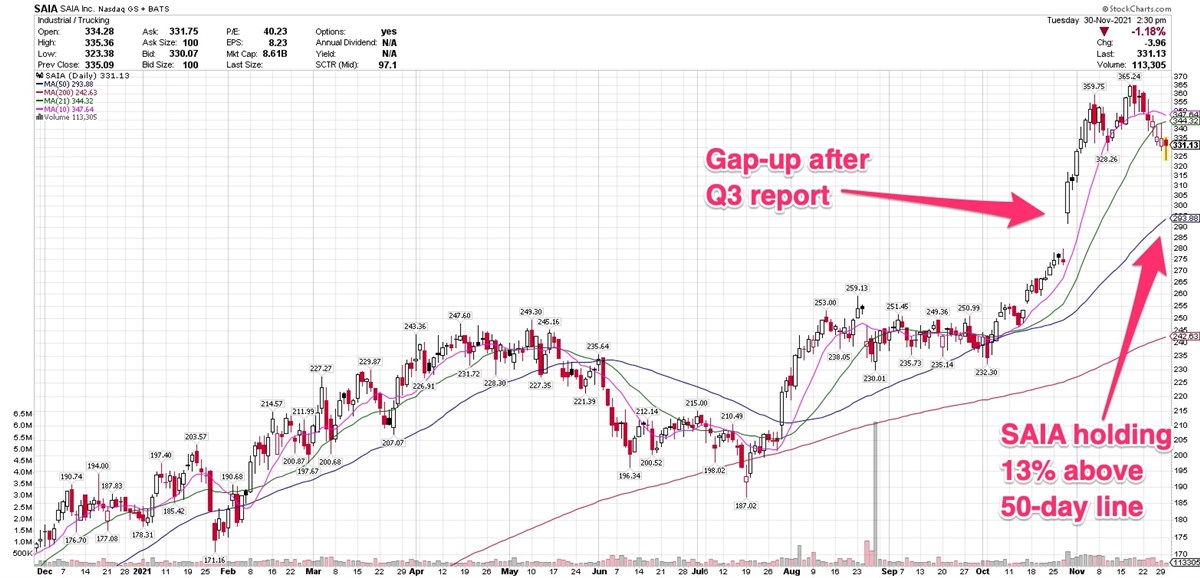Trucking Company Saia Pulls Back From Highs, But Holds Above Key Averages Trucking company Saia (NASDAQ: SAIA) is forming a potentially constructive area of consolidation below a November 17 high of $358.33.
By Kate Stalter
This story originally appeared on MarketBeat

Trucking company Saia (NASDAQ: SAIA) is forming a potentially constructive area of consolidation below a November 17 high of $358.33.
The Georgia-based company specializes in multi-regional less-than-truckload shipping. It also provides expediting and logistics services, as well as "non-asset-based" services. That means partnering with subcontractors or leasing equipment. Saia has grown through a series of acquisitions in recent years.
The stock gapped up nearly 14% on October 26 following a third-quarter report that beat views on the top- and bottom lines.
The company earned $2.86 per share, ahead of the consensus view calling for $2.33 per share. That marked a year-over-year increase of 83%.
Revenue was $616.22 million for the quarter, topping estimates by 8.35%, and a rise of 28% over the year-ago revenue of $481.37 million.
According to MarketBeat earnings data, Saia exceeded the consensus revenue and earnings estimates in each of the past six quarters.
Strong Earnings And Revenue Growth
Revenue grew at double-digit rates in the past two quarters. Earnings grew at double- or triple-digit rates in six of the past eight quarters. Growth slowed in the fourth quarter of 2019 and the second quarter of 2020, but the company managed to grow annual earnings in both those years.
For the full year, Wall Street expects Saia to earn $9.14 per share, which would mark a 76% increase. Next year, that's pegged at $11.25 per share, a gain of 23%.
Analyst data compiled by MarketBeat show a consensus rating of "buy," with a price target of $291.14, a downside of 11.38%.
It can seem counterintuitive that analysts are recommending a stock as a "buy," when they also expect a price drop in the next 12 to 18 months (or sooner). But the rating indicates that analysts have confidence in the stock's longer-term prospects.
In the company's third-quarter earnings call, president and CEO Frederick Holzgrefe was asked whether Saia is facing inflationary pressure concerning wages.
Goldman Sachs' Jordan Alliger asked, "How is the best way to think about 2022? Is it best to look at it like compensation per ton growth or just rate of change year-over-year relative to revenues, if you could give me some sense?"
"Keep in mind, we've got two wage increases this year, one in January and then another one in mid-August. So at the moment, we wouldn't foresee two of those next year," said Holzgrefe.
He added that the company's percentage range of wage increases in the past few years is between 3.5% and 4.5%. "It feels like pure wage inflation and on that same line, you've got benefits inflation, which has been low single-digit year-in and year-out. That's probably the right way to think about it just off of this year's base run rate of expense."
Building New Facilities
The company is bolstering growth with a series of new terminal and facility openings. In a November 16 press release, the company announced the opening of a new terminal, near Staunton, Virginia.
"In addition to capacity, the new facility will provide customers with more direct shipping points in the region and beyond," the company said.
In 2021, Saia opened new facilities in Connecticut, Delaware, Maryland, Ohio, and Virginia.
"Our strategy for expansion that kicked off in 2017 has really changed the footprint and profile of the company," said Jared Mull, a company vice president, in a statement. "As you might imagine, we're tremendously excited about 2022 as we plan to open 10 to 15 new terminals in addition to relocating several existing facilities."
Given the potential, is Saia currently a buy?
The current pullback remains mild, and the stock is getting support well above key moving averages. On Tuesday, it was trading between $331 and $332, holding 13% above its 50-day line. It's currently beneath both its 10- and 21-day averages, and I'd prefer to see it begin to trade higher again, regaining one or both of those lines, before investors initiate a buy. 










